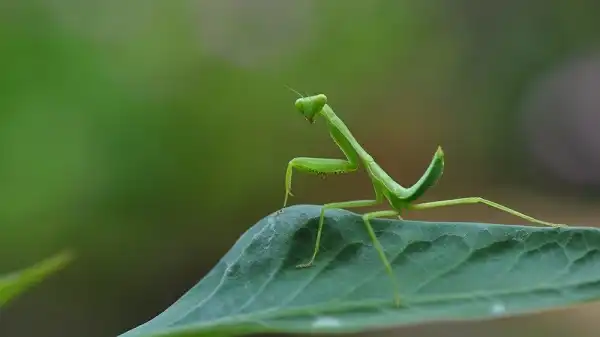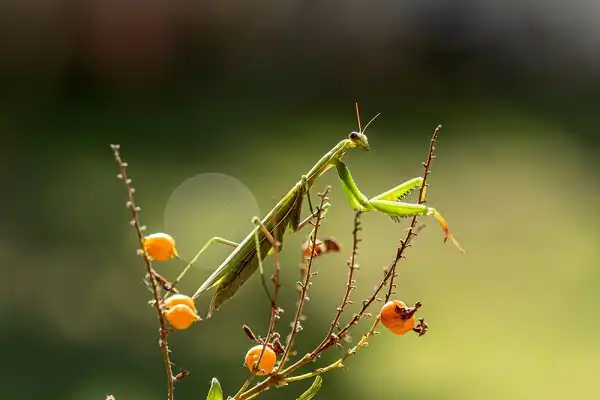Praying mantis are an incredibly fascinating species, distinguished by their remarkable powers of camouflage and eye-catching appearance. Even though praying mantises have been around for centuries, their secrets and behaviors can still surprise us today. Whether you’re an experienced hobbyist or simply curious to learn more about this animal, join us as take a closer look into the mysterious world of the praying mantis.

Praying Mantis Description
Praying mantises are fascinating creatures that have captured the attention of humans for centuries due to their unique behaviors and incredible abilities. These insects are typically green or brown in color, although some species can also be pink, yellow, or even white. They are known for their elongated bodies, triangular heads, and prominent eyes. One of the most interesting features of praying mantises is their incredible camouflage abilities. These insects are able to blend in seamlessly with their surroundings, which makes them difficult for predators to spot. Their bodies are covered in tiny spines that help to break up their outline and disguise their appearance. Interestingly, praying mantises are one of the few insects that have the ability to rotate their heads almost 180 degrees. This allows them to have a wider field of vision and better track the movements of their prey.
Praying Mantis Habitat
Praying mantises are found in almost every continent of the world, except for Antarctica. They can thrive in a range of habitats, from tropical jungles to arid deserts. However, their preferred habitat is usually grasslands, forests, and areas with dense vegetation. These insects are known to be adaptable and can survive in a variety of environmental conditions. They are also found in both rural and urban areas, as they are attracted to outdoor and indoor light sources. In addition to their natural habitats, praying mantises can also be found in gardens, parks, and other areas of human habitation. In fact, these insects can be beneficial to gardeners as they feed on pest insects that can cause damage to plants. The specific habitats that praying mantises prefer can vary based on their species. Some species prefer to live in trees, while others prefer to live on the ground. Some species can even survive in harsh, desert-like environments.
Praying Mantis Diet
Praying mantises are carnivorous predators that typically feed on other insects. They have a voracious appetite and can consume up to 5 times their body weight in food each day. In addition to smaller insects, praying mantises can also feed on larger animals such as lizards, frogs, and even birds. In some cases, they may even feed on smaller members of their own species. Praying mantises can occasionally supplement their diet with vegetation, such as fruits and flowers. However, this is not a common practice for these insects. Overall, praying mantises are opportunistic predators that will feed on whatever prey they can find. They rely heavily on the presence of other insects in order to sustain themselves and reproduce successfully. Therefore, it is important to ensure that there is adequate food available in a mantis’s natural environment in order to keep them healthy and thriving.

Praying Mantis Size
Praying mantises come in a variety of sizes, with the smallest species measuring just half an inch in length and the largest measuring up to 6 inches long. Overall, their size depends on their species and geographic location. One of the largest species of praying mantis is the Chinese mantis, which can reach up to 5 inches in length. These insects are larger and weigh more than many other species. On the other hand, the European mantis is much smaller, measuring only about two inches in length. When it comes to their body size, praying mantises are often slender and elongated with distinctly triangular heads. They have two large, compound eyes that are spaced apart on their head, which gives them exceptional vision and the ability to spot their prey from a distance. They also have powerful, spiny forelegs that they use to catch and hold onto their prey.
Praying Mantis Lifespan
The lifespan of a praying mantis can vary depending on the species, habitat, and environmental conditions. Generally, praying mantises can live for up to 1 year in the wild, although some species can live longer under ideal circumstances. Factors such as temperature, humidity, and availability of food can greatly impact the lifespan of a praying mantis. In warmer climates with plenty of food, mantises may live longer and go through multiple mating seasons. However, in colder climates, the mantis may only have a few months to live before temperatures decrease. Overall, the lifespan of a praying mantis can be affected by various factors, but under favorable conditions, they can survive for up to a year or longer. Their life cycle and development are fascinating, and they continue to intrigue scientists and nature enthusiasts alike.
Praying Mantis Behavior
Praying mantises exhibit unique behaviors that make them fascinating creatures to observe. They are stealthy predators that use their long, spiny forelegs to capture and hold onto their prey. While they are primarily solitary insects, some species have been known to exhibit communal behavior. Another interesting behavior exhibited by praying mantises is their use of mimicry. As mentioned earlier, many species of mantis use mimicry to blend into their surroundings and avoid detection by their prey. However, some species have taken mimicry to the next level by mimicking other animals in order to deter potential predators. For example, some mantises have been observed mimicking the appearance and movements of ants, which are not typically preyed upon by other insects. Praying mantises also exhibit a unique form of communication. While they do not have vocal cords, they can use body language and visual cues to signal to potential mates. Female mantises may release pheromones to signal their readiness to mate, while males may use their forelegs to grasp onto the female’s body during mating.

Praying Mantis Speed
Praying mantises have evolved over time to be incredibly fast and agile predators. Their ability to quickly capture prey allows them to survive in their environments, and it has made them an effective hunting tool for humans as well. Mantises are able to move at astonishing speeds; some species can reach up to 60 mph (96 km/h), making them the fastest insects in the world! This speed is largely thanks to their long wingspan and powerful leg muscles, which propel them forward with each flap. Mantises also possess quick reflexes that allow them to make split-second decisions when capturing prey. The agility of praying mantises gives them an advantage when it comes to balancing on tall plants or branches. They have a unique way of walking that gives them superior stability and mobility, allowing them to walk along thin surfaces with ease. This agility also allows them to make quick turns and swoop in on unsuspecting prey.
Praying Mantis Hunting
Praying mantises are renowned for their exceptional hunting abilities, which are driven by their lightning-fast reflexes, incredible agility, and unmatched stealth. These insects are natural-born predators that can rapidly and efficiently capture their prey, thanks to their extensive adaptations and hunting strategies. One of the most notable hunting techniques employed by praying mantises is their use of camouflage. With their slender bodies and elongated limbs, mantises closely resemble the branches and twigs of their natural habitats, making them almost invisible to their prey. Many mantises also have coloration and patterns that help to blend them into their surroundings, adding another layer of camouflage.
Once a mantis has identified its target, it moves with lightning speed and precision, relying on its exceptional vision and muscular system. Mantises have large, complex eyes that can detect even the slightest movement from up to 60 feet away, allowing them to track their prey with remarkable accuracy. They are also capable of perceiving depth, enabling them to judge distance and trajectory with ease. At the moment of attack, praying mantises to strike with incredible force, using their sharp claws to quickly and accurately seize their prey. Many species of mantis also have specialized spiny forelegs that can impale or crush their victim, ensuring a swift and efficient kill. Once the prey has been subdued, the mantis consumes it, often starting with the head or other vital organs.
Praying Mantis Different Species
Praying mantises are an incredibly diverse species, with over 2,400 known species located all over the world. These vary significantly in size, color, and behavior depending on their habitat range. Some of the most notable types of praying mantis include: – The Chinese Mantis (Tenodera sinensis): The largest mantis in North America with a body length of up to four inches long; it is native to East Asia but has spread throughout Europe and North America as an invasive species. – The European Mantis (Miomantis caffra): This medium-sized mantis is found from Portugal to South Africa, and is noted for its bright green coloration. – The Indian Flower Mantis (Creobroter gemmatus): A species native to South India, Sri Lanka and the Maldives; it is named for its striking pink and white flower-like coloration. – African Ghost Mantis (Phyllocrania paradox): This is one of the most popular pet mantises in the world due to its unique, ghostly appearance. It is found throughout Central Africa.

Conclusion
The praying mantis is a remarkable insect that is renowned for its astonishing speed and agility. From their unique hunting techniques to their sophisticated vision and muscular system, these incredible creatures have evolved numerous adaptations that allow them to survive in a wide variety of environments. Despite their tiny size, mantises are formidable predators that can rapidly capture prey and deftly evade danger with ease. Overall, the remarkable capabilities of praying mantises will continue to captivate scientists and nature enthusiasts alike. What’s more, the behavior of praying mantises is also noteworthy; they exhibit complex social behaviors such as cooperation when hunting or caring for the young.
Frequently Asked Question

